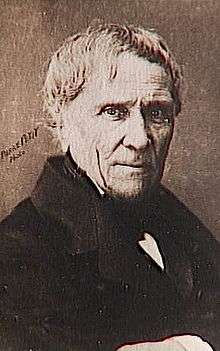Antoine César Becquerel
Antoine César Becquerel (7 March 1788 – 18 January 1878) was a French scientist and a pioneer in the study of electric and luminescent phenomena.
Antoine César Becquerel | |
|---|---|
 | |
| Born | 7 March 1788 |
| Died | 18 January 1878 (aged 89) |
| Nationality | French |
| Alma mater | École Polytechnique |
| Known for | Differential Galvanometer |
| Awards | Copley Medal |
| Scientific career | |
| Fields | Electricity, Electrochemistry |
| Institutions | École Polytechnique Muséum National d'Histoire Naturelle |
| Notes | |
Note that he is the father of A. E. Becquerel, and the grandfather of Henri Becquerel. | |
Life
He was born at Châtillon-sur-Loing (today Châtillon-Coligny). After passing through the École polytechnique he became engineer-officer in 1808, and saw active service with the imperial troops in Spain from 1810 to 1812, and again in France in 1814. He then resigned from the army and devoted the rest of his life to scientific investigation.[1]
In 1820, following the work of René Just Haüy, he found that pressure can induce electricity in every material, attributing the effect to surface interactions (this is not piezoelectricity). In 1825 he invented a differential galvanometer for the accurate measurement of electrical resistance. In 1829 he invented a constant-current electrochemical cell, the forerunner of the Daniell cell. In 1839, working with his son A. E. Becquerel, he discovered the photovoltaic effect on an electrode immersed in a conductive liquid.
His earliest work was mineralogical in character, but he soon turned his attention to the study of electricity and especially of electrochemistry. In 1837 he became a Fellow of the Royal Society, and received its Copley Medal for his various memoirs on electricity, and particularly for those on the production of metallic sulphurets and sulphur by electrolysis. He was the first to prepare metallic elements from their ores by this method. It was hoped that this would lead to increased knowledge of the recomposition of crystallized bodies, and the processes which may have been employed by nature in the production of such bodies in the mineral kingdom.[1]
In biochemistry he worked at the problems of animal heat and at the phenomena accompanying the growth of plants, and he also devoted much time to meteorological questions and observations. He was a prolific writer, his books including Traité de l'électricité et du magnétisme (1834–1840), Traité de physique dans ses rapports avec la chimie (1842), Elements de électro-chimie (1843), Traité complet du magnétisme (1845), Elements de physique terrestre et de meteorologié (1847), and Des climats et de l'influence qu'exercent les sols boisés et non boisés (1853). He died in Paris, where from 1837 he had been professor of physics at the Museum d'Histoire Naturelle.[1]
He became a correspondent of the Royal Institute in 1836, when that became the Royal Netherlands Academy of Arts and Sciences in 1851, he became a foreign member.[2]
He was the father of the physicist A. E. Becquerel and grandfather of the physicist Henri Becquerel. His name is one of the 72 names inscribed on the Eiffel Tower.
See also
- List of works by Eugène Guillaume
- A. E. Becquerel (his son)
- Henri Becquerel, (his grandson)
- Jean Becquerel (his great-grandson)
Notes
- Chisholm 1911.
- "Antoine César Becquerel (1788–1878)". Royal Netherlands Academy of Arts and Sciences. Retrieved 29 January 2016.
References

- Royal Society (brief biographical details)
- Catholic Encyclopedia article